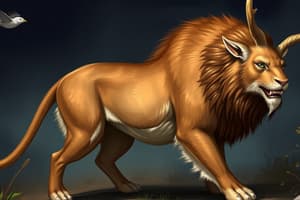Podcast
Questions and Answers
What is the primary function of a placenta in placental mammals?
What is the primary function of a placenta in placental mammals?
- To provide food and oxygen to the developing young (correct)
- To protect the developing young from predators
- To provide shelter for the developing young
- To regulate the body temperature of the developing young
Which order of placental mammals is characterized by having sharp incisor teeth and being primarily plant-eaters?
Which order of placental mammals is characterized by having sharp incisor teeth and being primarily plant-eaters?
- Order Carnivora
- Order Rodentia (correct)
- Order Xenarthra
- Order Logomorpha
What is a unique feature of the order Chiroptera?
What is a unique feature of the order Chiroptera?
- The ability to change body color for camouflage
- The ability to store food in cheek pouches
- The use of sonar for navigation (correct)
- The ability to fly using wings
Which order of placental mammals is characterized by having toothless or peg-like teeth and being primarily insect-eaters?
Which order of placental mammals is characterized by having toothless or peg-like teeth and being primarily insect-eaters?
What is a common feature among mammals in the order Primates?
What is a common feature among mammals in the order Primates?
How many different orders of placental mammals are represented?
How many different orders of placental mammals are represented?
What is a unique feature of monotremes' bone structure?
What is a unique feature of monotremes' bone structure?
What happens to the offspring of marsupials shortly after birth?
What happens to the offspring of marsupials shortly after birth?
Which of the following is NOT a characteristic of marsupials?
Which of the following is NOT a characteristic of marsupials?
Where can monotremes be found in the wild?
Where can monotremes be found in the wild?
What is the primary difference between monotremes and marsupials?
What is the primary difference between monotremes and marsupials?
Flashcards are hidden until you start studying
Study Notes
Characteristics of Mammals
- Class Mammalia divided into three subgroups based on reproductive methods: monotremes, marsupials, and placental mammals.
Monotremes
- Egg-laying mammals exemplified by the duck-billed platypus and echidna.
- Found exclusively in Australia, Tasmania, and New Guinea.
- Unique traits include reptilian-like bone structure in the shoulder area and lower body temperature than most mammals.
- Chromosomes exhibit a mix of sizes: normal mammal size and smaller reptile size.
Marsupials
- Characterized by short gestation periods; offspring enter a pouch after birth.
- Offspring develop and are nourished by milk from mammary glands within the pouch.
- Predominantly found in Australia and surrounding islands; the opossum is the sole native marsupial in North America.
Placental Mammals
- Feature a placenta providing food, oxygen, and waste removal for developing young.
- Births produce young that do not require pouch development.
- Represented by 18 different orders, showcasing significant diversity in adaptations.
Orders of Placental Mammals
- Order Insectivora: Includes shrews, hedgehogs, moles; small, underground insectivores with pointed snouts.
- Order Chiroptera: Bats, active at night, utilizing sonar for navigation, adapted for flight, consuming fruits and insects.
- Order Primates: Comprising monkeys, apes, and humans; exhibit binocular vision, larger brains, tree-dwelling habits, and opposable thumbs.
- Order Xenarthra: Includes anteaters, sloths, armadillos; notable for toothless or peg-like teeth adapting them for insectivory.
- Order Rodentia: Features beavers, rats, squirrels, etc.; possess sharp incisor teeth suited for herbivorous diets.
- Order Lagomorpha: Rabbits, pikas, and hares; characterized by longer back legs compared to front legs for jumping, with continuously growing incisors.
- Order Carnivora: Comprising dogs, cats, wolves, bears, and seals; specialized teeth for tearing flesh, making them proficient meat-eaters.
Studying That Suits You
Use AI to generate personalized quizzes and flashcards to suit your learning preferences.




